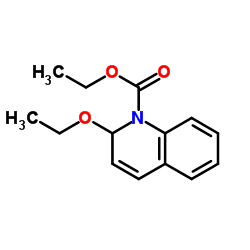N-Ethoxycarbonyl-2-ethoxy-1,2-dihydroquinoline

N-Ethoxycarbonyl-2-ethoxy-1,2-dihydroquinoline structure
|
Common Name | N-Ethoxycarbonyl-2-ethoxy-1,2-dihydroquinoline | ||
|---|---|---|---|---|
| CAS Number | 16357-59-8 | Molecular Weight | 247.290 | |
| Density | 1.2±0.1 g/cm3 | Boiling Point | 355.9±42.0 °C at 760 mmHg | |
| Molecular Formula | C14H17NO3 | Melting Point | 62-67 °C(lit.) | |
| MSDS | Chinese USA | Flash Point | 169.0±27.9 °C | |
| Symbol |

GHS07 |
Signal Word | Warning | |
|
Monoamine receptor agonists, acting preferentially at presynaptic autoreceptors and heteroreceptors, downregulate the cell fate adaptor FADD in rat brain cortex.
Neuropharmacology 89 , 204-14, (2014) FADD is a crucial adaptor of death receptors that can engage apoptosis or survival actions (e.g. neuroplasticity) through its phosphorylated form (p-FADD). Although FADD was shown to participate in receptor mechanisms related to drugs of abuse, little is know... |
|
|
Dengue type four viruses with E-Glu345Lys adaptive mutation from MRC-5 cells induce low viremia but elicit potent neutralizing antibodies in rhesus monkeys.
PLoS ONE 9(6) , e100130, (2014) Knowledge of virulence and immunogenicity is important for development of live-attenuated dengue vaccines. We previously reported that an infectious clone-derived dengue type 4 virus (DENV-4) passaged in MRC-5 cells acquired a Glu345Lys (E-E345K) substitution... |
|
|
Evidence for segregation of sphingomyelin and cholesterol during formation of COPI-coated vesicles.
J. Cell Biol. 151 , 507-18, (2000) In higher eukaryotes, phospholipid and cholesterol synthesis occurs mainly in the endoplasmic reticulum, whereas sphingomyelin and higher glycosphingolipids are synthesized in the Golgi apparatus. Lipids like cholesterol and sphingomyelin are gradually enrich... |
|
|
Studies on the application of temperature-responsive ion exchange polymers with whey proteins.
J. Chromatogr. A. 1438 , 113-22, (2016) Several new types of temperature-responsive ion exchange resins of different polymer composition have been prepared by grafting the products from the co-polymerisation of N-phenylacrylamide, N-iso-propylacrylamide and acrylic acid derivatives onto cross-linke... |
|
|
Self-oligomerization and protein aggregation of alpha-synuclein in the presence of Coomassie Brilliant Blue.
Eur. J. Biochem. 268(2) , 295-301, (2001) alpha-Synuclein has been implicated in various neurodegenerative disorders, including Parkinson's and Alzheimer's diseases, by its participation in abnormal protein depositions. As the protein has been suggested to play a significant role in the formation of ... |
|
|
Infrared spectroscopic study of the amidation reaction of aminophenyl modified Au surfaces and p-nitrobenzoic acid as model system.
Phys. Chem. Chem. Phys. 12(39) , 12427-9, (2010) We have investigated the fundamental amidation reaction by a model system consisting of an electrochemically functionalised Au surface by aminophenyl and 4-nitrobenzoic acid activated by EEDQ. The development of the NO(2) related stretching vibrations with ti... |
|
|
Autoreceptor preference of dopamine D2 receptor agonists correlates with preferential coupling to cyclic AMP.
Neuroreport 12(7) , 1473-9, (2001) Dopamine autoreceptors control the synaptic release and turnover of dopamine. Some dopamine agonists display a preference for modulation of autoreceptor functions rather than postsynaptic-driven behaviors. However, the nature of this apparent selectivity is s... |
|
|
The effect of assay formats on the estimation of melanocortin agonist affinity and efficacy using the operation model of agonism.
Eur. J. Pharmacol. 615(1-3) , 33-9, (2009) Melanocortin MC(3) and MC(4) receptor agonists have pharmaceutical benefit in the regulation of energy homeostasis. These agonists are defined by two parameters, their potency and their efficacy. However, these parameters are dependent upon the system in whic... |
|
|
Carboxyl residues in the iron-sulfur protein are involved in the proton pumping activity of P. denitrificans bc(1) complex.
Biochemistry 40(50) , 15396-402, (2001) A study is presented on chemical modification of the three subunit Paracoccus denitrificans bc(1) complex. N-(Ethoxycarbonyl)-2-ethoxy-1,2-dihydroquinoline (EEDQ) treatment caused a loss of the proton pumping activity of liposome-reconstituted bc(1) complex. ... |
|
|
Differential protection and recovery of 5-HT1A receptors from N-ethoxycarbonyl-2-ethoxy-1,2-dihydroquinoline (EEDQ) inactivation in regions of rat brain.
Neurochem. Res. 26(2) , 113-20, (2001) The effect of N-ethoxycarbonyl-2-ethoxy-1,2-dihydroquinoline (EEDQ) on 5-HT1A receptors was studied in Sprague Dawley rats. A single dose of EEDQ (4 mg/kg body wt., i.p.) significantly inactivated 5-HT1A receptors, as measured by [3H]8-hydroxy-2-[di-n-propyla... |